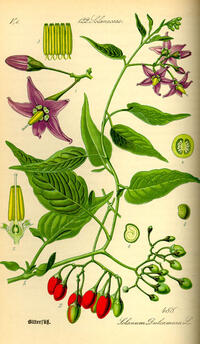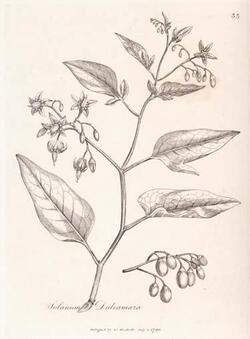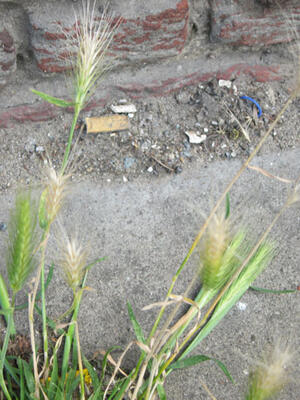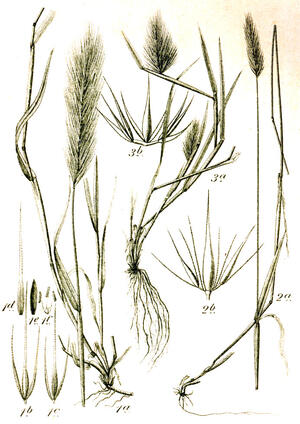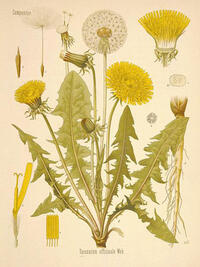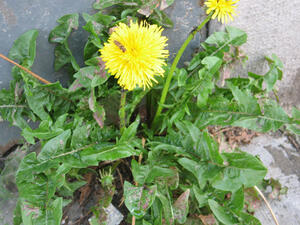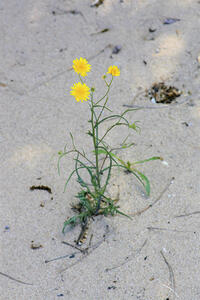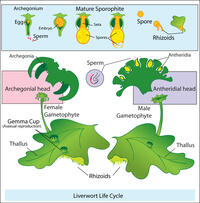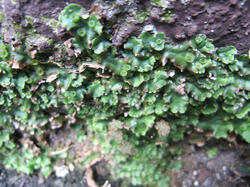This is an old revision of the document!
Brussels Plants
the information about plants which grows around the FoAM building/ Koolmijnenkaai 30-34
Solanum dulcamara
is a species of vine in the potato genus Solanum, family Solanaceae. It is native to Europe and Asia, and widely naturalised elsewhere, including North America, where it is an invasive problem weed. It occurs in a very wide range of habitats, from woodlands to scrubland, hedges and marshes. In the days of belief in witchcraft, shepherds used to hang it as a charm round the necks of those of their beasts whom they suspected to be under the evil eye.The older physicians valued Bittersweet highly and applied it to many purposes in medicine and surgery, for which it is no longer used. It was in great repute as far back as the time of Theophrastus, and we know of it being in use in this country in the thirteenth century. Gerard says of it:'The juice is good for those that have fallen from high places, and have been thereby bruised or beaten, for it is thought to dissolve blood congealed or cluttered anywhere in the intrals and to heale the hurt places.' Boerhaave, the celebrated Dutch physician, considered the young shoots superior to Sarsaparilla as a restorative, and Linnaeus, who at first had an aversion to the plant, later spoke of it in the highest terms as a remedy for rheumatism, fever and inflammatory diseases of all kinds. There are few complaints for which it has not been at some time recommended.
—Medicinal Action and Uses— The drug possesses feeble narcotic properties, with the power of increasing the secretions, particularly those of the skin and kidneys. It has no action on the pupil of the eye. It is chiefly used as an alterative in skin diseases, being a popular remedy for obstinate skin eruptions, scrofula and ulcers. It has also been recommended in chronic bronchial catarrh, asthma and whoopingcough. For chronic rheumatism and for jaundice it has been much employed in the past, an infusion of 1 OZ. of the dried herb to 1/2 pint water being taken in wineglassful doses, two or three times daily. From the fluid extract made from the twigs, a decoction is prepared of 10 drachms in 2 pints of boiling water, boiled down to 1 pint, and taken in doses of 1/2 to 2 OZ. with an equal quantity of milk. The berries have proved poisonous to a certain degree to children. Fluid extract, 1/2 to 2 drachms.
http://www.botanical.com/botanical/mgmh/n/nighwo06.html http://en.wikipedia.org/wiki/Solanum_dulcamara
Hordeum murinum (wall barley)
Wall barley is an annual grass common in central, southern and eastern England, and scattered elsewhere. It is found on waste and rough ground and barish patches in rough grassland. It occurs on the margins of cultivated fields. Distribution is related both to the availability of ruderal habitats and to climate. Frequency decreases with increasing rainfall combined with decreasing temperatures, although, it can cope with greater rainfall if temperatures are higher. In ruderal situations it extends further into cooler wetter regions by taking advantage of features such as the base walls where conditions are locally warmer and drier. Wall barley is part of a complex of overlapping subspecies whose centre of distribution is in the Mediterranean region. Subspecies murinum is the native grass in the UK. Sub-species leporinum and glaucum are introduced casuals. In Australia, biotypes of the latter two sub-species have been reported with resistance to the herbicide paraquat In New Zealand, wall barley is a particular problem to stock. The sharply pointed seeds can penetrate the eyes, mouth and skin of sheep causing animal losses and devaluing the pelts. The level of damage is influenced by the breed of sheep, mainly due to differences in the structure of the coat. Sheep dogs too are affected when the seeds become embedded between their toes.
http://www.gardenorganic.org.uk/organicweeds/weed_information/weed.php?id=125
- Plantago major(Broad-Leaved Plantain)
- Buddleja Davidii (Butterfly Bush)
Pissenlit officinal or Taraxacum officinale(Dandelion)
There is some doubt, however, as to whether it was really the shape of the leaves that provided the original notion, as there is really no similarity between them, but the leaves may perhaps be said to resemble the angular jaw of a lion fully supplied with teeth. Some authorities have suggested that the yellow flowers might be compared to the golden teeth of the heraldic lion, while others say that the whiteness of the root is the feature which provides the resemblance. Flückiger and Hanbury in Pharmacographia, say that the name was conferred by Wilhelm, a surgeon, who was so much impressed by the virtues of the plant that he likened it to Dens leonis. In the Ortus Sanitatis, 1485, under 'Dens Leonis,' there is a monograph of half a page which concludes:'The Herb was much employed by Master Wilhelmus, a surgeon, who on account of its virtues, likened it to “eynem lewen zan, genannt zu latin Dens leonis” (a lion's tooth, called in Latin Dens leonis).' In the pictures of the old herbals, for instance, the one in Brunfels' Contrafayt Kreuterbuch, 1532, the leaves very much resemble a lion's tooth. The root is not illustrated at all in the old herbals, as only the herb was used at that time. The name of the genus, Taraxacum, is derived from the Greek taraxos (disorder), and akos (remedy), on account of the curative action of the plant. A possible alternative derivation of Taraxacum is suggested in The Treasury of Botany:'The generic name is possibly derived from the Greek taraxo (“I have excited” or “caused”) and achos (pain), in allusion to the medicinal effects of the plant.'
Many little flies also are to be found visiting the Dandelion to drink the lavishly-supplied nectar. By carefully watching, it has been ascertained that no less than ninety-three different kinds of insects are in the habit of frequenting it. The stigma grows up through the tube formed by the anthers, pushing the pollen before it, and insects smearing themselves with this pollen carry it to the stigmas of other flowers already expanded, thus insuring cross-fertilization. At the base of each flower-head is a ring of narrow, green bracts the involucre. Some of these stand up to support the florets, others hang down to form a barricade against such small insects as might crawl up the stem and injure the bloom without taking a share in its fertilization, as the winged insects do. —History— The first mention of the Dandelion as a medicine is in the works of the Arabian physicians of the tenth and eleventh centuries, who speak of it as a sort of wild Endive, under the name of Taraxcacon. In this country, we find allusion to it in the Welsh medicines of the thirteenth century. Dandelion was much valued as a medicine in the times of Gerard and Parkinson, and is still extensively employed. Dandelion roots have long been largely used on the Continent, and the plant is cultivated largely in India as a remedy for liver complaints.
Crepis tectorum (Narrow-Leaved Hawk's-Beard)
Crepis(Crepis tectorum) is a genus of about 200 annual and perennial flowering plants found in the family Asteraceae resembling Dandelion, the main differences being that Hawksbeards have multiple flowers per plant as well as branching stems. The name Crepis derives from Greek, meaning 'shoe'. In some parts of the world the genus is known as Hawksbeard. Species can be found all through the northern hemisphere and tropical Africa. Crepis species are used as food plants by the larvae of some Lepidoptera species including Broad-barred White.
http://en.wikipedia.org/wiki/Crepis
- Conyza canadensis
- Galinsoga ciliata
Marchantiophyta/Pellia epiphylla (Liverwort)
Most liverworts are small, usually from 2–20 millimetres (0.08–0.8 in) wide with individual plants less than 10 centimetres (4 in) long, so they are often overlooked. The most familiar liverworts consist of a prostrate, flattened, ribbon-like or branching structure called a thallus (plant body); these liverworts are termed thallose liverworts. However, most liverworts produce flattened stems with overlapping scales or leaves in three or more ranks, the middle rank being conspicuously different from the outer ranks; these are called leafy liverworts or scale liverworts.
Liverworts have a gametophyte-dominant life cycle, with the sporophyte dependent on the gametophyte. Cells in a typical liverwort plant each contain only a single set of genetic information, so the plant's cells are haploid for the majority of its life cycle. This contrasts sharply with the pattern exhibited by nearly all animals and by most other plants. In the more familiar seed plants, the haploid generation is represented only by the tiny pollen and the ovule, while the diploid generation is the familiar tree or other plant. Another unusual feature of the liverwort life cycle is that sporophytes (i.e. the diploid body) are very short-lived, withering away not long after releasing spores. Even in other bryophytes, the sporophyte is persistent and disperses spores over an extended period. –Ecology– Today, liverworts can be found in many ecosystems across the planet except the sea and excessively dry environments, or those exposed to high levels of direct solar radiation. As with most groups of living plants, they are most common (both in numbers and species) in moist tropical areas.Liverworts are more commonly found in moderate to deep shade, though desert species may tolerate direct sunlight and periods of total desiccation.
